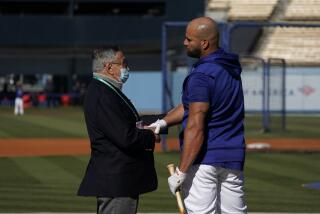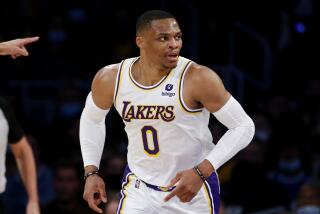How MLB got from Marlins’ “super-spreading event” to World Series

- Share via
Major League Baseball was aware that a player on the Miami Marlins had tested positive for the coronavirus before the team opened a three-game series in Philadelphia in July, according to a report released Thursday.
The league came under scrutiny on the day of the third game of the series, when word surfaced that four players on the Marlins had tested positive but the game against the Philadelphia Phillies was played as scheduled.
The Marlins’ outbreak, which infected 20 members of the team’s traveling party and forced the team to shut down for more than a week, was labeled a “super-spreading event.”
The Marlins’ information was included by the Centers for Disease Control as part of its Morbidity and Mortality Weekly Report. Dr. Ali Khan, an expert in infectious diseases and the lead consultant to MLB in developing its health and safety protocols, was one of the authors of the report on the Marlins’ case.
The initial protocols, which were approved by public health officials, did not call for a team to be shut down after one player tested positive. The league made changes to its protocols and, after two significant outbreaks in two weeks, completed its abbreviated season without another outbreak.
On July 22, the same day that the Marlins played an exhibition game in Atlanta against the Braves, the Miami players completed their every-other-day test for COVID-19, as required under the MLB protocol. On July 24, before the Marlins’ scheduled game in Philadelphia, one of those tests came back positive.
The NHL has postponed the 2021 editions of its Winter Classic and All-Star Weekend, citing “ongoing uncertainty resulting from the coronavirus.”
The unidentified player, who had shown no symptoms, was isolated. The Marlins put one player on the injured list that day, catcher Jorge Alfaro, but did not say why. Alfaro later said he had contracted the virus.
The game against the Phillies went on, but so did expedited testing, and tracing to identify players deemed to have come into close contact with the infected player.
After the July 25 game, three additional Marlins players received positive test results. The Marlins and Phillies went ahead with their July 26 game and, after the game, eight more Marlins players and staff members received positive test results.
The Marlins did not play again until Aug. 4.
In the wake of the Marlins’ outbreak — and in the midst of an outbreak that shut down the St. Louis Cardinals for more than two weeks — the league reinforced its directives about social distancing; required players and staffers to wear masks on airplanes and buses, within hotels and in all public places; prohibited visits to hotel bars, lounges and other such public gathering spots; and added a compliance officer for each team.
The league also decided to postpone games as soon as a player tested positive. In August, when an Oakland Athletics player tested positive, the league promptly shut down the team until MLB could be assured the virus had not spread. No other players tested positive, and the A’s resumed play after a five-day shutdown.
No MLB player tested positive over the final 30 days of the regular season, the league said. The players moved into bubbles for the postseason, with the Dodgers and Tampa Bay Rays set for Game 3 of the World Series Friday.
According to the report released Thursday, MLB determined that 168 players and other employees had been exposed to the virus as a result of the Marlins’ super-spreader event.
Rays defeat Dodgers in Game 2 of World Series
On the Marlins, 20 of 68 persons tested positive, a rate of 29%. However, on the Phillies, one of 31 persons tested positive: a staffer who worked in the Marlins’ clubhouse. On the Braves, none of 38 persons tested positive.
The report noted that “asymptomatic, unknowingly infected players and coaches spent more than a cumulative 11 hours on the field” and yet no opposing players, coaches or umpires became infected. The report concluded that the virus most likely spread off the field, through “indoor exposures.”
Given the lack of evidence for transmission of the virus on the field, the report said outdoor sports might be safe for high school and club teams, provided that participants abide by social distancing and mask wearing off the field, and by avoiding public gatherings. That finding is important, the report said, as “frequent testing and dedicated contact tracing might not be realistic options for most nonprofessional teams.”
More to Read
Go beyond the scoreboard
Get the latest on L.A.'s teams in the daily Sports Report newsletter.
You may occasionally receive promotional content from the Los Angeles Times.













